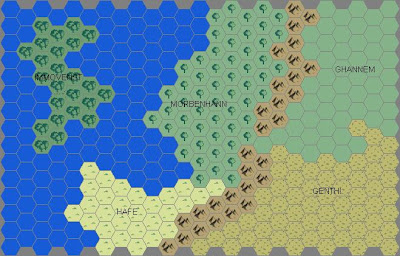
I've been thinking about sword & sorcery again lately, having recently purchased the RPG.net darling
Barbarians of Lemuria from Lulu and the decidedly nasty new comic
Viking from my local shop (which doesn't have any sorcery, but gets me in the S&S mood anyway). This, in turn, got me thinking about injecting more of the genre's flavor into the game of high-magic asskickery known as D&D 4th edition.
Soon I was reacquainting myself with Bob Bledsaw's
Wilderlands of High Fantasy setting, which, despite the name, is more of a S&S-flavored pulp fantasy mashup than "high fantasy" in tone. I am a proud owner of all of Necromancer Games' d20-based Wilderlands material. Though I don't plan on running D&D 3rd edition ever again, I will probably hang on to those books (and especially the Wilderlands boxed set) until I keel over.
Anyway, I was flipping through the
Player's Guide to the Wilderlands the other day with an eye towards using it with a system other than 3rd edition, and I actually think it'd be easy to use 4th edition for it without eliminating any of 4e's core elements, since the Wilderlands setting is chock-full of weird D&Disms in the first place (having been designed for that game, after all).
The 4e classes, really, fit just fine. Sure, having a bunch of friendly spellcasters running around with the fighter-types isn't very S&S at all, but as I said, I think the Wilderlands are more about putting a Frazetta veneer over D&D than anything else. If you wanted to make things more true to the genre, you'd probably want to dump a few of the newer, crazier classes - like the swordmage or artificer - but if you can have a crashed Soviet MiG in the mountains, I guess you can have a guy who shoots acid out of his sword.
Even "non-traditional" 4e races like tieflings and dragonborn are a surprisingly easy fit. The existing Wilderlands history already includes references to "Orichalan dragon-lords". Dragonborn are easily recast as a former servitor race of the Orichalans, or maybe even as degenerate descendants of the dragon-lords themselves.
Likewise, the Wilderlands already include an entire region to the south controlled by infernal powers and a shadowy race called the "demonborn". Using the 4e stats for tieflings, you have an easy stand-in for the demonborn, who are pretty much overpowered as written in the Wilderlands Player's Guide anyway. Or you could just use tieflings as-is and tie their backstory in with the demonborn.
You would need to write up a new Amazon race for 4e, though. Making a race that doesn't use much armor is tricky in any system, but at least there's already the beastmaster ranger build, so it'd be easy to have the archetypal Frazetta spearwoman, complete with smilodon friend.
I have a feeling that adapting the Wilderlands gods would be as simple as reassigning the various Channel Divinity feats from the 4e deity to Thor or Armadad Bog or what have you. There are already plenty of them between the 4e PHB and the Forgotten Realms Player's Guide, with more coming in Divine Power.
It... could... work!
 I really need to learn to buy (and read) one RPG rulebook at a time. Having too many cool books laying around is wreaking havoc with my gamer ADD.
I really need to learn to buy (and read) one RPG rulebook at a time. Having too many cool books laying around is wreaking havoc with my gamer ADD.

 PUT THE PIPE DOWN CLYDE PLEASE
PUT THE PIPE DOWN CLYDE PLEASE








 I've got a problem. I haven't run anything in almost a year, and I miss it.
I've got a problem. I haven't run anything in almost a year, and I miss it.








